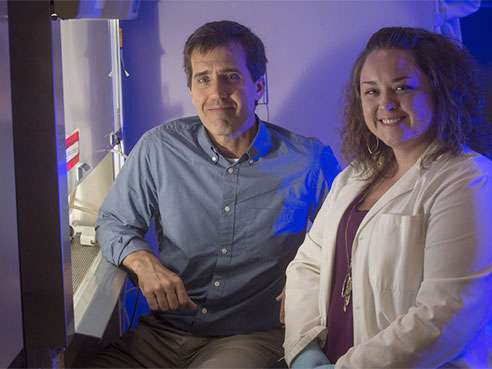Therapeutically robust correction, in vitro, of the most common cystic fibrosis mutation

In experiments with isolated cystic fibrosis lung cells, University of Alabama at Birmingham researchers and colleagues from two other institutions have partially restored the lost function of those cells.
The work is proof-of-concept for using a yeast genetic model to find therapeutic targets, in this case for people with the most common cystic fibrosis mutation, called deltaF508-CFTR. This mutation affects close to 90 percent of patients with cystic fibrosis, and half of those have two copies of the mutation.
"The research is the first preclinical study, to our knowledge, that demonstrates therapeutic levels of deltaF508-CFTR function in primary patient cells," said John L. Hartman IV, M.D., associate professor in the UAB Department of Genetics and the Gregory Fleming James Cystic Fibrosis Research Center.
The work was recently published in PLOS Biology, and it will next be tested in animal models of cystic fibrosis, says Kathryn Oliver, the graduate student who did the laboratory work at UAB.
Cystic fibrosis is a progressive genetic disease marked by persistent lung infections that lead to lung damage and severe difficulty in breathing. The lungs of healthy people produce about two quarts of mucus a day. This mucus is transported up to the throat by the waving motion of hair-like cilia on the cells that line the respiratory tract, a conveyor-belt-like activity that removes bacteria, viruses and small particles that were inhaled into the lungs.
The defective gene in cystic fibrosis results in a thick, viscous mucus that resists transport. The gene product, called CFTR, is a tiny channel that pushes chloride ions across the cell membrane of secretory epithelial cells. Water moves along with those ions to lubricate the extracellular cilia and, consequently, the mucus. In cystic fibrosis patients, the channel is broken, so the cilia and mucus do not get hydrated.
UAB researchers, along with colleagues at McGill University, Montreal, Canada, and Emory University, Atlanta, restored the chloride channel by the additive effects of suppressing a ribosomal protein called Rpl12 and use of the investigational drug VX-809, or Lumacaftor. Together, these two treatments were able to restore CFTR chloride transport to 50 percent of the normal activity in bronchial epithelial cells. This level, if achieved in patients, could be enough to produce healthy lung function.
This work is proof-of-concept for discovering novel therapeutic targets for patients, using genomewide gene interaction analysis with a yeast homolog. The common ancestor of yeast and humans diverged about a billion years ago, but there is still enough functional conservation between some pairs of yeast and human genes that they can be substituted for each other.
"We are curious about the extent to which yeast genetic models can reveal gene interaction networks relevant to human disease," Hartman said. "For cystic fibrosis, this yeast phenomics approach appears to be very useful."
Details
Cystic fibrosis (CF) occurs when a person inherits a dysfunctional copy of the CFTR protein from his or her mother and father, yielding two mutations in that patient. CFTR stands for the CF transmembrane conductance regulator, an ATP-powered ion channel that spans the cell membrane. The most common CF mutation, deltaF508-CFTR, is a deletion of one phenylalanine amino acid residue from the CFTR protein. This deletion interferes with proper folding of the CFTR protein inside the cell, leading to degradation of the nascent polypeptide at the endoplasmic reticulum.
Yeast has a homolog to CFTR called YOR1, a pump that exports the mitochondrial toxin oligomycin, making the yeast resistant to oligomycin. From an evolutionary perspective, YOR1 is in the same protein family as CFTR and possesses the equivalent mutation to human deltaF508-CFTR, known as deltaF670-YOR1. DeltaF670-YOR1 is misfolded and degraded in yeast cells in a manner similar to deltaF508-CFTR in human lung cells. Thus, deltaF670-YOR1 was introduced systematically into every one of approximately 4,700 different yeast strains, each harboring loss of function in a single yeast gene. The purpose? To find targets for rescuing the misfolding of deltaF670-YOR1.
DeltaF670-YOR1 function is measured by changes in oligomycin resistance that were detected by new technology developed in the Hartman laboratory—quantitative high-throughput cell array phenotyping, or Q-HTCP. This technology collects tens of thousands of growth curves simultaneously, allowing precise and accurate quantification of the growth response of all 4,700 mutants to inhibitory treatments like oligomycin.
In these unbiased yeast studies, numerous genes, including RPL12, were identified as potential targets that could restore proper deltaF670-YOR1 folding and prevent endoplasmic reticulum-associated degradation, and therefore, by analogy, also rescue deltaF508-CFTR activity. Based on the yeast results, experiments with human CF cells were conducted using small interfering RNA to suppress levels of the corresponding target proteins, particularly RPL12, a ribosomal stalk protein involved in translation of mRNA. This inhibition of RPL12 increased the plasma membrane density, function and stability of deltaF508-CFTR at the apical surface of primary bronchial epithelial cells isolated from five different patients carrying deltaF508-CFTR.
Suppression of RPL12 slows the rate of translation elongation of nascent deltaF508-CFTR protein at the ribosomal surface, which may reduce the amount of misfolded proteins during synthesis. When RPL12 inhibition was combined with the small-molecule corrector VX-809, CFTR function in mutant cells increased to 50 percent of the wild-type level, which is well above the 30 percent threshold believed to be beneficial for patients with CF. VX-809 acts as a molecular chaperone to promote folding of deltaF508-CFTR, but the drug showed only modest benefits in clinical trials with patients who have two copies of the deltaF508-CFTR mutation.
Taken together, this work provides the first evidence that novel therapeutic strategies for human patients can be identified based on yeast studies, and that targeting a ribosomal protein (Rpl12) together with VX-809 can rescue CFTR function to therapeutically relevant levels.
More information: Guido Veit et al, Ribosomal Stalk Protein Silencing Partially Corrects the ΔF508-CFTR Functional Expression Defect, PLOS Biology (2016). DOI: 10.1371/journal.pbio.1002462
















